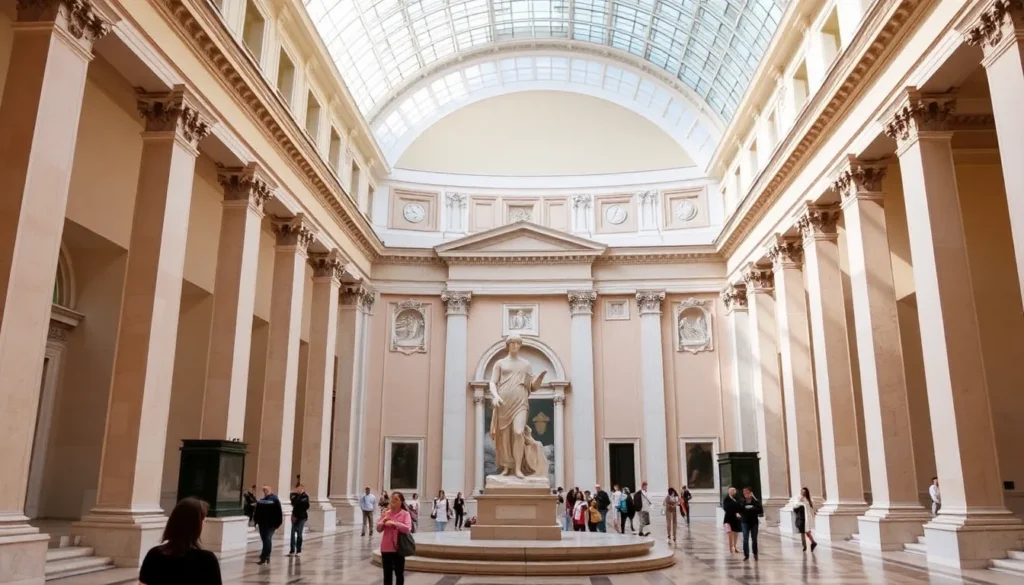Visit the Vatican Museums: Tips and Useful Information

Are you planning a trip to Rome and eager to visit the Vatican Museums? You’re not alone! Many travelers find themselves overwhelmed by the sheer size and splendor of these museums. Not to worry, we’ve compiled a comprehensive guide to help you navigate this fascinating destination with ease and enjoyment.
Ready to embark on your journey through the Vatican Museums? Let’s dive in!
1. A Brief History of the Vatican Museums
The origins of the Vatican Museums date back to 1503, when Pope Julius II became the first to donate his private art collection to the public. This initial act sparked a tradition that would see successive popes and influential families contribute to the vast collection we see today.
The term “Museums” is plural for a reason; the Vatican comprises a total of 19 museums, each housing diverse collections ranging from classical archaeology to contemporary art. The treasures within include artifacts from ancient Egypt and Rome, relics from the Etruscan civilization, and masterpieces by renowned artists such as Michelangelo, Raphael, and Botticelli.
Visitors can explore over 7 kilometers of galleries, staircases, and rooms, each designed by some of the greatest architects of their time. The crown jewel of this collection is undoubtedly the Sistine Chapel, featuring Michelangelo's breathtaking frescoes—a must-see for anyone visiting the Vatican.
2. Opening Hours of the Vatican Museums
The Vatican Museums are open from Monday to Saturday, 09:30 AM to 06:00 PM (with the last access at 04:00 PM), and on the last Sunday of each month, from 09:00 AM to 02:00 PM (with free entry). They are closed on most Sundays.
During the summer months (from late April to late October), Friday and Saturday hours are extended until 10:30 PM (last access at 08:30 PM).
→ Before your visit, it’s advisable to check the official hours here.
3. Admission Fees for the Vatican Museums
The general admission ticket costs €17, while reduced tickets are available for €8 (for children ages 6-18 and students up to 25 years old). If you wish to include an audioguide, there’s an additional charge of €7. Note that advance reservation is mandatory for visiting the Vatican Museums, and an online booking incurs a €4 processing fee.
IMPORTANT: This ticket grants you access to the Museums (including the Sistine Chapel), but does not include priority entry to St. Peter's Basilica, which is free but typically involves long lines unless you arrive early or book a guided tour.
Free admission days to the Vatican Museums include the last Sunday of each month, World Tourism Day (September 27), and for minors under 6 years, persons with disabilities, and other exceptional cases.
* While the entry is free on these occasions, it’s generally required to join a guided tour (also available in Spanish), which typically costs €18.
→ You can make your reservation on the official website here up to two months in advance.
4. Opting for a Guided Tour in Spanish (with Entry Included)
One of the best ways to explore the Vatican Museums is through a guided tour in Spanish. This option allows you to benefit from the insights of an expert guide who can provide a richer understanding of the exhibits, helping you make the most of your visit without the stress of planning an itinerary by yourself.
Book your guided tour of the Vatican Museums with a guide here.
The downside to this option is that guided tours have fixed start and end times, limiting your flexibility. If you are an art enthusiast and want to linger over the artworks, consider purchasing a standard entry ticket and renting an audioguide instead. However, if you want to hit the highlights without missing key artworks and understand their significance, this is a solid choice (note that the tour typically lasts about 3 hours).
Would you like to enjoy exclusive access to the Vatican Museums? There’s a special tour that allows you to enter at 08:00 AM, one hour before regular hours, giving you the chance to admire the Sistine Chapel almost in solitude. This exclusive experience comes at a premium. You can book it here.
5. Directions to the Vatican Museums
The entrance to the Vatican Museums is located at Viale Vaticano (map). Upon entering, visitors will find services such as a cloakroom, information desk, guided tour office, currency exchange, childcare, emergency medical services, and a souvenir shop.
To reach the museums via public transport, consider the following options:
- Metro: Use the “Cipro-Musei Vaticani” or “Ottaviano” stations (both on Line A).
- Bus: Lines 32, 81, and 982 stop at Piazza del Risorgimento nearby. Line 49 travels along Viale Vaticano and stops right at the museum entrance, while lines 492 and 990 stop at Vía Leone IV.
- Tram: The Risorgimento-S. Pietro stop (Line 19) is also an option.
Keep in mind that the Vatican Museums and St. Peter's Square are somewhat distanced from each other, so plan your day accordingly, deciding which site to visit first.
Once inside, you’ll arrive at the Courtyard of the Four Gates, which will serve as your central reference point during the visit. From here, you can choose between two marked itineraries, indicated by colored arrows guiding you through the museum's halls and rooms: one shorter and one longer.
The short itinerary (approximately 2 hours) covers the most significant works and collections, making it ideal for those pressed for time or not wishing to explore extensively. The long itinerary is more comprehensive and recommended for those who wish to delve deeper, allowing for a visit of at least 4 to 5 hours.
With so many galleries spread over three floors (one level for the entrance hall and two additional levels for exhibitions), it’s essential to keep track of the must-see items. For a detailed account of the major works and artifacts in the Vatican Museums, check out this article on key highlights.
You can also download a map outlining the major rooms and key objects, as well as a recommended itinerary:
→ For a PDF version, download here.
To enhance your visit, consider these helpful tips:
- Purchase your ticket in advance online, even if it costs a little extra. Alternatively, book a guided tour that includes skip-the-line entry. Arriving without a reservation could mean long waits or missing out on entry altogether.
- If you have the Omnia Vatican and Rome Card, you can also visit the Vatican Museums, but be sure to reserve in advance.
- When is the best time to visit the Vatican Museums? Avoid peak days like the last Sunday of the month (a free entry day), early mornings, Saturdays, and Mondays. The latter is especially busy as many city museums are closed on Sundays, attracting tourists who missed out.
- If you plan to visit St. Peter's Basilica on the same day, keep in mind that while entry is free, lines can be lengthy. Consider joining this guided tour in Spanish with dome access—a top seller!
- Inside the Vatican Museums, there are specific rules to follow:
- Dress code: Ensure your shoulders and knees are covered. Opt for long pants or skirts to avoid any issues.
- Large backpacks, tripods, and any other unusual items (like that pocket knife you often carry) are prohibited. A complimentary cloakroom service is available.
- Photography is allowed without flash throughout the museum, except in the Sistine Chapel, where no photos are permitted. Memorize those stunning frescoes!
For more useful tips for visiting the Vatican Museums, check out this link.
This is our comprehensive guide to visiting the Vatican Museums, packed with essential information, hours, prices, and all the tips you need to enjoy one of Rome's most iconic destinations.
| Save on your trip |
| Compare and find cheap flights here |
| Find accommodation at the best prices here |
| Book activities and excursions in Spanish here |
| Get a 5% discount on your travel insurance with IATI here |
| Reserve transfers from the airport here |
| Receive a gift of €10 by booking transport across Europe here |
| Learn how to withdraw money without fees here |
| Get a 5% discount on your eSIM with Holafly here |
| Rent a car with the best deals here |
| Check out the best books and travel guides here |
| Explore all our articles about Rome |




Deja una respuesta